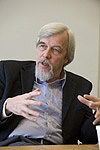Global vision
 |
| Rolf Heuer |
Editor's note: CERN Director General Rolf Heuer wrote today's Director's Corner, the first of an occasional series of exchanges. Fermilab Director Pier Oddone's usual Tuesday Corner will appear in Friday's CERN Bulletin. Fermilab Today will provide a link.
Globalization is part of the early 21st century zeitgeist, but for particle physics it's nothing new. Our field has always worked globally. When CERN was established in the 1950s, Fermilab did not yet exist. Brookhaven was CERN's natural American partner and competitor. Competition was fierce, though not in the traditional sense of the word. Then as now, our objectives were shared and although each lab wanted to be first, the overriding goal was generating knowledge and innovation for the common good. Back then, when Brookhaven scientists developed the technique of strong focussing, their instinct was to share it with CERN. The result was that our 10 GeV proton synchrotron became a 25 GeV machine that started up 50 years ago, and Brookhaven even helped us commission it. Today's equivalent is manifest in the unprecedented level of support that CERN is receiving from other labs, notably Fermilab, in preparing the LHC for a restart later this year. Yes we're in competition, but it's a healthy competition that benefits us all - regardless of where the discoveries and technological advances are made.
Particle physics has been a global field for longer than our two laboratories have existed, and up to now there has been an equitable exchange of scientists between the major particle physics regions: the Americas, Asia and Europe. Particle physicists from around the world have always been welcome at any laboratory with the infrastructure for their research. With the LHC, however, our field has reached a turning point. Just as before, CERN maintains an open door policy and we have over 100 nationalities in our user community. What's changed, however, is the flow of scientists. Although originally a European project, the LHC is becoming the global focus for particle physics, and it is safe to assume that future projects of a similar scale will be conceived as global from the start.
Much has been made of the CERN Council working group on geographical and scientific enlargement of CERN. This is, in my opinion, a necessary step for Europe to redefine its role on the global stage. Among the subjects being considered by the group is the current membership structure of CERN, offering differing conditions for Members, Observers and countries with collaboration agreements. In today's world, is this still an appropriate structure? Probably not. The group will also pave the way for CERN to play the role it was created for - coordinating fundamental physics research in Europe, and representing Europe on the world stage.
The time is right for the particle physics community and its funding agencies to develop a truly global vision of the field. Some projects can be hosted by national labs and others by regional facilities. Some will be global from the outset. Whatever the scale, we must ensure that all the research we do is world-class, and that all our facilities are open to the free flow of scientists. We should ensure that where the science is worth doing, it is done, while being careful to use resources responsibly without duplication of effort.
The future of particle physics will be healthiest if there are strong national, regional and global projects, all coordinated on a global scale. The CERN Council working group is an important step in that direction. Today, globalization is a fact of life, and the particle physics community has the opportunity to show the way to better optimization of global resources.
Have a question for the CERN DG?
Submit it here.
|